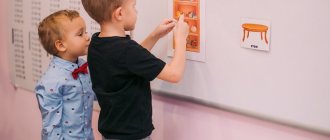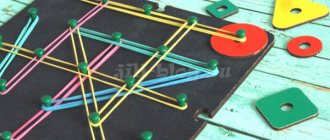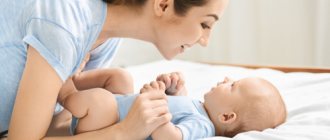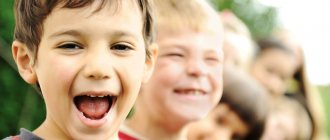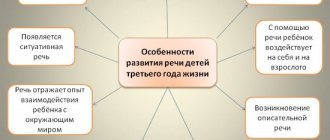Article:
A child’s speech at 2 years of age is actively formed against the background of the development of basic mental processes.
Thinking helps him compare objects with each other and establish simple connections. Increasing the stability of attention allows you to listen to stories or reading by an adult. Memory and perception are increasingly improved and make it possible to master the norms of the native language with great success. Listening to short fairy tales and short stories is already meaningful; a child can repeat after an adult complex words, simple phrases, and retell a small part on his own. In the second year of life, the baby is interested in everything that happens around him. He observes the objects of the surrounding world and masters the actions that can be performed with them. The main guides to the world of new information are adults from the immediate environment. But the baby can get help and new knowledge from them if he speaks. Communication with loved ones is the main incentive to master the native language between the ages of two and three years.
Content:
- Physical Development Physical Skills and Movement
- Fine motor skills
- Weight and height
- What to do if the child still does not start speaking at 2 years old?
- Cognitive development
- Nutrition
- Games
Physical development
Parents may worry if the child is too thin or, conversely, overweight, however, the main thing is that he continues to grow at a stable pace.
At 2 years, in addition to growth, you will also notice obvious changes in the baby’s appearance. Body proportions begin to change. Children's muscles become stronger and, if previously the baby had a round, plump tummy and short arms, now in terms of body structure he becomes more like a preschooler than a baby.
Physical skills and movement
At this age, children can run and fall noticeably less.
At 2 years old a child can:
- jump on the spot;
- ride a tricycle;
- recognize objects and name them (if he doesn’t speak yet, then point them with a pen);
- climb and descend stairs almost independently, sometimes using an adult’s hand or stair railings for balance;
- kick and catch the ball;
- stand on one leg for a few seconds;
- stand on tiptoes;
- run;
- climb on and off furniture independently;
- pulling toys on a broken string while walking.
Be there while your little one explores the world. This will make the child feel safe. With your support now, he will be able to confidently start something new in the future.
Safety
When your baby is so active, it's a good idea to think about his safety in the home. Check if you have taken care of all the points:
- All dangerous items, including medicines and washing powders, are kept high under lock and key.
- Furniture and TVs are securely attached to the wall. Even if a tall cabinet or chest of drawers seems very heavy and unliftable to you, a child can easily knock it over.
- Set the hot water temperature in the tap to no more than 50°C, if possible.
- Always supervise children near water.
- Install locks on the windows and do not leave your child in a room with an open balcony or window.
For the safety of the little ones, you can use a GPS watch. By connecting them to the “Where are my children” application, you will always be calm about your child. The presence of a geo-tracker and the Surround Sound function will tell you how the baby is doing if you left him with a nanny for a while or if the baby started going to nursery.
Fine motor skills
Two-year-olds already enjoy playing with small objects. This helps develop fine motor skills.
The child can:
- string beads onto a cord;
- collect small items in containers;
- turn the pages of books;
- collect a pyramid;
- unfasten Velcro and zippers;
- hold a spoon, fork, comb.
When playing and practicing with small objects, do not leave your baby alone - he may swallow them or put them in his nostril or ear.
Weight and height
In the second year of life, growth and weight gain slow down noticeably. Moreover, boys are on average 0.8-1 kg heavier than girls and slightly taller.
When comparing your child’s performance with the generally accepted ones, it is important to remember: all children are different. As a rule, there is no need to panic if there is a slight deviation from the norm . Moreover, during visits to the pediatrician, the doctor still continues to measure the weight and height of the baby every time.
Analyze your baby's height and weight:
| Indicators of girls at 2 years old | Indicators of boys at 2 years old | ||||||
| Weight, kg) | Height (cm) | Weight, kg) | Height (cm) | ||||
| Lower border and upper | Norm | Lower border and upper | Norm | Lower border and upper | Norm | Lower border and upper | Norm |
| 8,1-13 | 11,5 | 76,7-89,6 | 86,4 | 8,6-15,3 | 12,2 | 78,3-93,6 | 87,5 |
⠀ Although boys tend to be larger than girls, such important parameters as chest and head circumference are not yet very different. On average, at 2 years old, a boy’s head circumference should be about 47.5 cm, and his chest circumference should be 48.5 cm. For girls, the norm for head circumference is 46.5 cm, and chest circumference is 48.5 cm.
Sense organs
At 2 years old, the baby pays attention to everything around him. The child is interested in bright colors and different textures. He can already distinguish objects by shape, size and color. The senses help him understand the world.
Vision
At this stage of development, children receive the main information through vision. At 2 years old, they can distinguish primary colors, and from 2 to 3 years old they begin to see pale and pastel shades. At the same time, it is still difficult for them to coordinate the visual system. For example, if a child loses sight of his mother in a crowd, he will not be able to quickly find her.
Develop your child's observation skills - this will improve his fantasy and imagination. And don’t forget about a scheduled visit to a pediatric ophthalmologist at age 2.
Touch
Tactile perception is now very important for the baby. The sense of touch helps him distinguish between soft and hard objects, hot and cold, as well as various textures (rough, ribbed, soft, velvet, etc.)
Hearing
Children at the age of 2 already perfectly understand the intonation with which an adult speaks. Also, kids immediately perceive familiar songs or rhymes by ear.
Loud noises are unpleasant for the baby. Try not to overload the child’s psyche with them. If this happens, let him rest in silence.
Smell and taste
Still at 2 years old, children often explore objects by placing them in their mouths. At the same time, the child is already able to distinguish between sweet and salty, sour and bitter. Also, the baby successfully remembers the characteristic taste of a particular product, the memory of which will remain for a long time. This will influence the formation of the baby’s taste preferences in the future.
Try to feed your child a variety of foods. The sooner he learns to recognize tastes, the better for the development of his sensory system.
Speech: how many words should a 2 year old child speak?
At 2 years old, children can use short sentences: it is already easier for the child to say what he wants. Soon he will learn and be able to use many new words, and it will become easier for you to understand him during conversations. Currently the child:
- knows the names of familiar people and the names of body parts;
- speaks sentences of 2 to 4 words;
- understands simple instructions;
- distinguishes and uses pronouns: “I” and “you”;
- repeats words heard;
- Finds, upon request, objects in pictures in a book.
What to do if the child still does not start speaking at 2 years old?
If there are obvious problems with speech, first of all, you need to contact a pediatrician and pediatric neurologist. Based on the medical history, the doctor will be able to suggest possible causes of speech delay: from hearing problems to developmental disorders. If necessary, the specialist will refer the young patient to specialists.
Treatment options for speech development in children depend on the cause of the speech delay and its severity. When no obvious violations are detected, it is better to wait a little and contact a neuropsychologist and speech therapist. As a rule, closer to 3 years of age, children without severe disabilities and with proper treatment begin to speak and soon catch up with their peers.
Signs of speech delay
After two years, some children cannot use speech as a means of communication due to the fact that children’s speech development is delayed. The cause of concern for their parents is the complete absence of speech or a limited number of available words. In addition to a poor vocabulary, speech development delay (SDD) is expressed by the following symptoms:
- the child cannot translate his thought into a speech message, he finds it difficult to answer an adult’s questions;
- active and passive vocabulary accumulate at a very slow pace;
- children have difficulty constructing even a short phrase: “The girl’s ball fell or the girl’s ball” (The girl’s ball fell);
- Children cannot not only build a common sentence on their own, but also repeat it after an adult, for example, Teddy bear came out of the forest;
- in spoken words there are often rearrangements of syllables and sounds, substitution of one sound for another;
- when pronouncing individual sounds, the child notices tension or twitching of the facial muscles;
- he does not understand the meaning of a fairy tale or nursery rhyme read by an adult, and finds it difficult to answer a simple question about its content or try to retell it;
- The baby has difficulty assembling nesting dolls, cubes, and cut-out pictures consisting of four parts.
Emotions and social skills
Emotional development plays a big role at this stage of development. The baby experiences many emotions that change rapidly and learns to control them. At the same time, the baby also learns about the feelings of other people. Parents need to help him differentiate between his feelings and express them correctly.
For example, outbursts of anger, embarrassment, disappointment are normal. Often children do not know how to express such vivid emotions. The child learns this from his parents, even if they do not focus on it. A child at this age skillfully reads all the information he needs from adults.
Also at this age, the child “gropes” for what is permitted: he observes how his behavior affects mom and dad.
For a two-year-old child it is normal if he:
- copies others, especially adults and older children;
- becomes emotionally overexcited when playing with other children, as well as from a large number of gifts and animated entertainment during the holidays;
- shows more and more independence;
- demonstrates defiant behavior (does what he was told not to);
- attracts other children to his games, especially when playing catch.
Favorite games
Two-year-old children prefer a variety of games, both athletic and calm. It is important for parents to help channel energy in the right direction and make sure that the baby not only has fun, but also develops.
The following activities will help:
- modeling from plasticine;
- drawing;
- applique of large elements.
Advice
You shouldn’t do everything for the child, wanting to quickly get a neat craft, this defeats the purpose of the exercise. You can only help him a little, show him how to properly hold a brush with glue in his hands, but the child must do the craft itself on his own.
Children's games are becoming more and more complex, children try to independently act out scenes from their favorite fairy tales, play doctor, build houses for toys, “feed” dolls, and come up with whole scenarios. Their favorite toys include cubes, from which the child builds towers.
Advice
Parents should purchase large puzzles, construction sets, and mosaics with large elements; they will be of interest to both boys and girls.
Children are becoming more and more comfortable communicating with both adults and peers; they enjoy playing with other kids on playgrounds.
Cognition and thinking
The age from 2 to 3 years is the very stage when your baby literally masters new skills every day.
Cognitive development
Everything that children have learned by the age of 2 develops their thinking. The child begins to understand concepts such as time and opposites - for example, big/small, day/night.
What a child at this age should be able to do:
- upon request, point with your finger at parts of the body that the adult names;
- compare and sort shapes and colors;
- remember what different things look like. For example, when a child is asked to find the color or shape of an apple on thematic cards, he remembers that the apple is red/round, etc.;
- find hidden things;
- play simple imaginary games;
- build towers of 4 or more blocks;
- use one hand more than the other;
- follow two-step instructions, such as “Take the toy and put it on the shelf.”
Create small tasks for your baby to develop fine motor skills, such as asking him to turn the page of a book.
Household skills
Around this time, children tend to do everything on their own. So, the baby will happily wash his hands himself, rub himself with a washcloth in the bathroom, and even put on simple items of clothing.
Fact: a 2-year-old child finds it easier to take off clothes than to put them on.
Don't worry about cleanliness in the kitchen - give your baby a spoon while eating. 2 years - it's time to learn to eat on your own , while the baby does it willingly. If you miss the moment, you will probably have to spoon feed your baby yourself for a long time in the future.
Since at this age the young explorer is interested in literally everything, take advantage of this to develop the confidence in your child to do something on his own. Allow him to help wash dishes, dust, or sweep the floor. The vacuum cleaner occupies a special place in the lives of children during this period. Let your little one pick up large debris from the floor himself with the help of an electric “friend.” To prevent too loud a sound from frightening your baby, reduce the power on the vacuum cleaner. The child will be very proud if he becomes your assistant.
Potty training
Watch your child - perhaps he is ready to use the potty. Below is a list of some signs. Please note if the child:
- can do most things you ask independently, without the help of an adult;
- wonders what adults do in the toilet;
- lets you know when he is doing his business in the diaper and asks to quickly change it to a clean one;
- follows simple instructions, such as “Give the ball to your brother”;
- knows how to sit on the potty, as well as pull off and put on panties.
Never put pressure on your child when potty training. This is one of the most difficult things for a baby.
And it is very important that he does not have negative memories with this topic. If you start requiring your baby to use the potty too early, it may take him longer to master the skill.
And one more piece of advice: pot is different from pot. Choose such an important item together with your child. Some people like musical pots, others like those with cartoon characters, and others like with a lid like a toilet.
Sleep and eating habits at 2 years old
As a rule, in the first six months to a year of life, the child’s sleep and wakefulness schedule is not very varied. But by the age of two, everything changes dramatically. Here is an approximate daily routine for a baby:
| Time | Actions |
| 7:00 | Getting up, hygiene procedures |
| 8:00 – 10:00 | Walk, games |
| 10:00 | Lunch |
| 10:30-12:30 | Walk, games |
| 12:30-13:00 | Dinner |
| 13:00 | Daytime nap |
| 15:00 | Climb |
| 15:30 | Afternoon snack |
| 16:00-19:00 | Walk, games |
| 19:00 | Dinner |
| 19.30 | Getting ready for bed (bath, reading books, massage) |
| 20:00/21:00 | Dream |
⠀
Don't get hung up on quantity and turn eating into a war. Keep in mind that your baby's appetite slows down as growth slows, and there may be times when your baby isn't very interested in eating.
Nutrition
By the age of two, children already have about 16-18 teeth and can chew well.
A two-year-old can:
- It’s good to sip from a mug;
- chew and swallow food well;
- distinguish between food and inedible objects;
- scoop food with a spoon;
- prick food with a fork and bring it to the mouth;
- express likes and dislikes for various products.
In the second year of life, babies learn to eat independently and switch to three meals a day and food from the common table. Babies love trying new tastes and textures. Below is a sample menu:
| ⠀Meal | Menu |
| Breakfast |
|
| Lunch |
|
| Dinner |
|
| Afternoon snack |
|
| Dinner |
|
⠀
Don't get hung up on quantity and turn eating into a war. Keep in mind that your baby's appetite slows down as growth slows, and there may be times when your baby isn't very interested in eating.
Dream
Babies need 11-14 hours of sleep . As a rule, this is 10-12 hours of sleep at night and a couple of hours of sleep during the day.
Children develop quickly, and at this age their sleep changes greatly. For example, babies may find it difficult to fall asleep or stay asleep through the night. In addition, at 2 years old, a child begins to test his independence, so getting him to sleep may be a challenge for a while.
Advice. As soon as you notice the first signs of your baby's fatigue, try to immediately put him to bed before lethargy and lack of strength turn into hysterics. Noisy games and strong emotions should be avoided before bedtime.
Stick to a solid daily routine . The regimen can be a good help in solving many problems with children's sleep. Create your own rituals before going to bed for the night. This could be, for example, a warm bath, massage and reading books. Over time, the baby will develop the habit that after certain actions, he goes to bed.
If your baby's naps take too long or start too late, he may not be ready for sleep until late at night.
Some babies like to wake up at 5:30 or 6:00 . Apparently, you were born a lark and nothing can be done about it. Putting your baby to bed late at night in the hope that he won't get up too early in the morning usually doesn't help . Your child may wake up early and then be fussy all day due to lack of sleep.
Dream
How long should a 2 year old baby sleep? In this matter, everything is much simpler. Daytime sleep takes at least 2 hours, and nighttime sleep takes 10. In total, a child should sleep 12 hours a day. It is advisable to strictly follow the regime.
The baby moves a lot, is active, and receives a lot of information from the world around him. Therefore, it is necessary to pay maximum attention to rest. Try not to break your routine, even if you are visiting or on a trip.
Often at this age, the baby is very resistant to daytime sleep. Laying down sometimes takes several hours. As a result, the entire routine is completely disrupted, and nighttime sleep is also postponed for an indefinite number of hours. How to put your son or daughter to bed on time? Here are some tips.
How to go to bed on time?
- Start getting ready for bed an hour in advance, reduce activity, read a book.
- Ventilate the room well and maintain the temperature at +20 degrees. This will be optimal for a relaxing holiday.
- Some mothers try to increase the interval between lunch and nap. On a full stomach, the baby does not really want to go to bed.
- Try to do the same actions before going to bed: for example, putting a soft bear or your favorite doll to bed. Or maybe listening to calm, soothing music will become your tradition. Gradually, the baby will learn to tune in to a wave of peace and relaxation.
- Keep track of what time your child starts to get tired. Perhaps you should move up your sleep hours a little. But it is also important that the child does not overdo it. This may have a negative impact on his psycho-emotional development.
- When your baby goes to nursery or kindergarten, he and the other children will quickly get used to going to bed at the same time.
- If a child said “no, I won’t sleep!”, then he said this to you, but not to the bear or bunny. They can “call” him to his crib with your voice. Include a quiet play moment, and the baby will join right away.
- If your baby is hyperactive, then before bed, slow down your movements and speak in a calmer and quieter voice. Place a pillow with mint or buckwheat flour in the crib (natural emotional sorbents).
- Remember that excess carbohydrates and glucose lead to tension and increased activity. Avoid giving sweets at least a few hours before bedtime.
- You can make a Dream Guardian - an Owl. And even together you can make it out of paper and decorate it, you can sew it or knit it, and then learn a rhyme. The owl is designed to protect sleep, and you can trust it with secrets and fears. It helps a lot when the baby is afraid to fall asleep alone in the room in the evening.
I'm telling you, Owl,
I'm the magic words.
The night looks out my window.
I don't like it when it's dark.
Drive away sadness and fears.
Guard my sleep carefully.
You should never give up and despair. Try not to force your baby to do anything. Observe his behavior more, and you will know when it is time to go to bed, and what to do if sleep does not go well.
Warning signs for parents
Each child develops at his own pace and it is impossible to say exactly when he will master this or that skill. Of course, there are developmental milestones, and if your baby hasn't reached them as he gets older, it's worth discussing this with your pediatrician. Contact a specialist if you notice the following problems in your two-year-old baby that indicate developmental delay:
- does not walk by 1.5 years (at 2 years you should have already found out the reason for this from doctors) or does not walk steadily;
- walks exclusively on tiptoes;
- does not speak at least 15 words or does not speak at all;
- does not know the functions of common household items (toothbrush, telephone, kettle, spoon, etc.);
- does not copy actions or words;
- does not follow simple instructions;
- cannot push a toy on wheels;
- doesn't even try to draw;
- does not pay attention and does not play with peers;
- cannot hold small objects in hand (for example, a crayon);
- loses the skills he once had.
No matter what happens, never shake your baby. This can cause bleeding inside the brain and likely permanent damage.
Possible difficulties
It is important for parents to prepare for the fact that children at two years old sometimes begin to show excessive independence and prove their position, be capricious, and disagree with the opinions of adults. Moms and dads are required to show patience, not to kill the child’s desire for independence, to give him the opportunity to perform certain actions on his own - getting dressed, washing himself - but under the control of his parents.
The difficulty may also be due to the fact that, faced with failure, the child may refuse further education - for example, he will not want to build a tower from blocks. Moms and dads will have to inspire the child: praise him, show him everything again, use play techniques (“let’s help the bear, build a tower for him”), and strive with all their might to interest the baby.
Advice
If a two-year-old child is capricious and refuses to comply with a parent’s request, you can complete the lesson and reschedule the task until tomorrow. Perhaps the child is just tired.
How to help a two-year-old child develop? Tips and Techniques
Here are some simple things you can do to help your baby's development at this age:
- Give your child the opportunity to play with others: play is a great way for your child to learn how to make friends and communicate socially. Don't expect kids to organize team play or willingly share toys. These skills will come much later - after 3-4 years.
- Encourage everyday skills - praise the fact that the baby used a spoon himself at lunch (it doesn’t matter that he had to wash the whole kitchen afterwards) or was able to put on his shoes before going for a walk. Such skills include both small and large muscle movements. In addition, during these actions, the baby undergoes a large-scale thought process: he thinks about what he is doing.
- Try to talk a lot with your child. Name objects, seen phenomena, body parts, household items - all this helps develop the baby’s language skills. At this age, it is important to make it clear to the child that, for example, a stool can be small or large, red or black, and even a “big black stool.”
- Give your baby's words and phrases completeness. If the baby says: “Mom, milk,” answer him: “Do you want Mom to bring you milk?” In addition to developing speech and thinking, it will make your child feel important and loved.
- Read to your child a lot and sing nursery rhymes. You can already repeat simple children's quatrains several times - the baby will definitely remember them, if not now, then a little later.
- Involve your child in simple cooking activities. At 2 years old, he can easily help stir batter with a spoon, stir porridge, or prepare sandwiches from pre-cut ingredients.
When your child masters a particular skill, be sure to praise him. And in the future, help him consolidate new knowledge: encourage the child to do what he has learned.
Games
Play at 2 years old is very, very important. Through play, a child learns to explore the world around him and learn to interact with others.
You can offer your child educational games that will help develop basic skills:
Changing clothes
Pack dolls or soft toys to go outside/visit/to bed. Invite your child to dress and undress himself. In addition to being a useful skill, this game will help your child overcome difficulties with clothing. For example, if he doesn’t like to wear a hat, play “in the winter”, invite the baby to warm his dolls or animals, simultaneously explaining that in the cold season you can’t do without a hat.
Tea party
At 2 years old, both girls and boys will react positively to such a game. Create a real feast for toys on the toy table. The child will learn to lay out food and memorize the name of the dishes. In addition, a toy tea party will prepare the baby for kindergarten: he will know what to eat from his plate, sit at the table during meals and even use a napkin if necessary.
Finger/Brush Painting
Such a pastime is, of course, extremely useful for the development of fine motor skills and imagination of the baby. In addition, the ability to hold a brush in your hand will not hurt on the eve of kindergarten. Don't forget to keep your child's first creations as souvenirs.
All kids at this age passionately love interesting stories. Tell your child funny facts from his biography, remember some moments from your childhood that will interest your baby, read books, look at pictures and fantasize together.
2 years is the age of active exploration of the world by a child. He has already learned to control his body, is very active, learns to think and masters speech. At this time, it is important to treat the baby as an individual - respect his desires and needs. Help your child develop correctly and harmoniously, take care of his physical and psycho-emotional health. And don’t forget about yourself - only happy parents have happy children!
Walk
You need to walk every day. No matter what the weather is like outside. Prepare several replacement sets of clothes and shoes: while one is drying, you can go for a walk in the other. Even if it’s unbearably cold or raining outside, dress warmly, take an umbrella and go out into the fresh air.
In the warm season, you need to go outside several times, but in the winter and off-season, check the weather. Perhaps you will go out only once, but before bedtime, so that the baby can run around and get a dose of fresh air.

